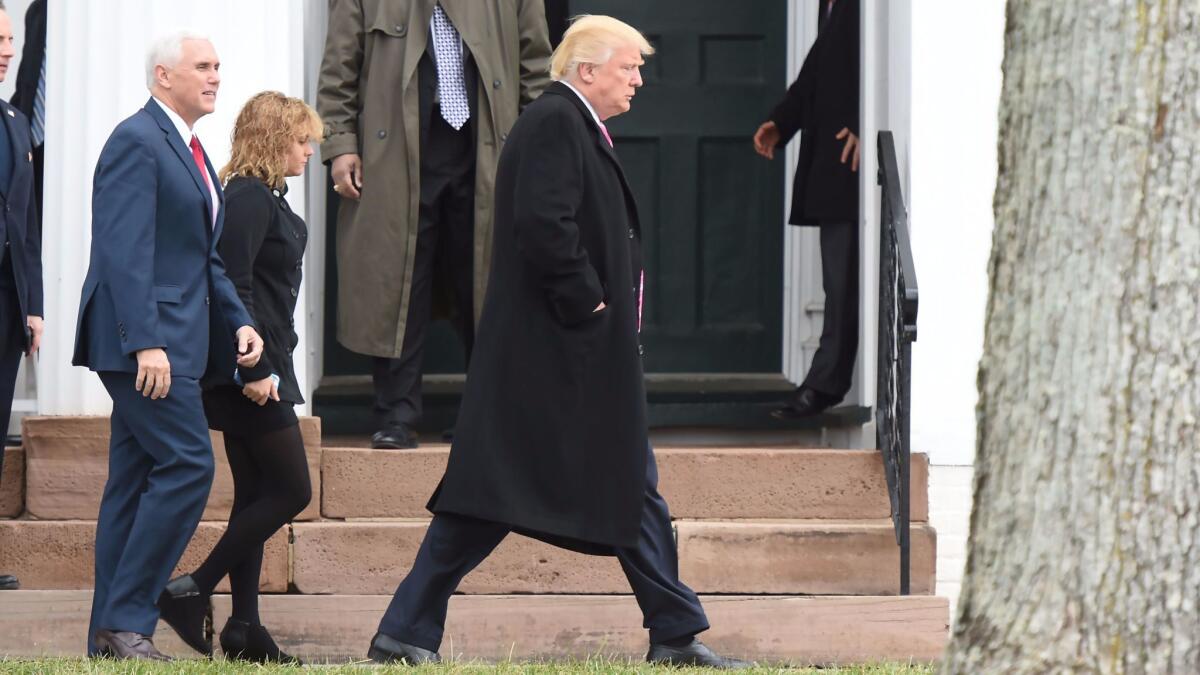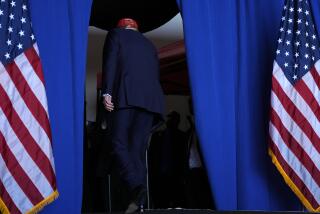Nearly a year after Trump’s election, both sides think they’re losing

- Share via
Reporting from Washington — Nearly a year after the election of a president who promised Americans would win so much they would grow “tired of winning,” a funny thing has happened in American politics — both sides think they’re losing.
That lose-lose mood, which is on display daily on Capitol Hill, is strongly reinforced by a study of public opinion released Tuesday by the nonpartisan Pew Research Center. More than 6 in 10 Americans say they believe their side is losing more than it’s winning on the issues that matter most; only about 1 in 4 think their side is mostly winning.
That attitude might not be surprising from Democrats, who, with the election, lost control of all three branches of the federal government. More strikingly, Republicans, too, think they’re getting the short end of the stick.
The Pew study is the latest in a series the research group has done for the past three decades using people’s answers to a battery of questions to group them into clusters according to political views. This year’s study produced eight such political groupings — four mostly Republican and four mostly Democratic — plus a ninth category of about 8% of the public who are primarily bystanders to America’s political debate.
Of the eight groups who do have opinions about politics, none has a majority who think their side is winning; only one has even a plurality who feel that way.
Among Democrats, that sense of loss undergirds the rage many feel as they see policies adopted under President Obama — or previous presidents — rolled back under President Trump.
On the GOP side, the belief that their side is losing, despite holding a majority in both houses of Congress, fuels conservative challenges to Republican incumbents and efforts to overthrow party leaders.
In addition to the question about winning, the pessimistic view jumps out from a question about whether life for the next generation of Americans will be better or worse than life today. Overall, 48% of those surveyed said worse, compared with 29% who said life would be better, continuing a downbeat view of America’s future that has dominated U.S. public opinion for more than a decade.
The two largest groups in Pew’s political typology — core conservatives and solid liberals — have fairly similar levels of pessimism about the next generation’s prospects, albeit for different reasons. In both groups, only about 3 in 10 feel the next generation will have better lives. Just over half the solid liberals and slightly less than half the core conservatives feel life will be worse.
Those two groups form the anchors of the nation’s two political party coalitions. About 1 in 5 politically active Americans fit into the core conservative grouping, Pew finds, while about 1 in 4 is a solid liberal.
The core conservatives are an overwhelmingly white, mostly male and financially comfortable group — slightly more than half say their families have achieved the American dream.
They hold traditional conservative views favoring small government and a positive view of American involvement in the global economy. Nine out of 10 feel discrimination against women is a thing of the past in the U.S., more than 8 in 10 say the country already has “made needed changes to give blacks equal rights” and a similar share feel that because of government benefit programs, “poor people have it easy.”
The solid liberals are also typically white and financially comfortable, mostly with college degrees or higher, and not traditionally religious. They’re also the most urban group.
They have a strong belief in the social safety net and the importance of government regulation, see inequality and discrimination as major problems in the country, have positive views of immigrants and overwhelmingly see openness to the rest of the world as a crucial American value.
In the aftermath of Trump’s election, solid liberals have become by far the most politically active part of the public. About half have contributed money to a candidate or campaign in the past year. Four in 10 have participated in a protest. Six in 10 have contacted an elected official. No other group in either party coalition comes close to that level of involvement, a gap which did not exist before Trump’s victory.
The major party coalitions rest on those two groups — slightly more than 4 in 10 Republicans are core conservatives and about half of Democrats are solid liberals — but both parties fill out their ranks with smaller groupings, some of which disagree in key respects with each other.
The Democratic-leaning groups generally share liberal views and opposition to Trump but disagree on the degree to which they believe the nation’s economic and political systems work. They also divide to some extent on their views of immigration.
Disagreements are sharper on the Republican side, particularly with two groups, which Pew calls country-first conservatives and market skeptics, that played important roles in Trump’s victory.
The county-first conservatives are heavily rural, mostly non-college-educated, religiously devout and older — about half say they are retired. About 1 in 6 live in households where at least one member belongs to a labor union, a share higher than any other group. Suspicion of immigrants and concern about the loss of American identity are key to their makeup. They’re also the only group in which a majority says society should discourage homosexuality.
The country-first conservatives are the only group that not only has a positive view of Trump’s job performance, but also a favorable view of how he conducts himself. Just over half say they approve of Trump’s conduct, a view shared by only about 1 in 6 of the public at large.
The market skeptics also lean to the GOP, but for different reasons. They’re not particularly religious or interested in social issues. Instead, they’re broadly suspicious of government, business and the political system. They’re not especially enamored of Trump, but believe that both the political and economic systems are unfair, and that neither party cares about the middle class. They’re the only Republican-leaning group that favors raising taxes on corporations and the wealthy.
The final GOP-leaning group, what Pew dubs new-era enterprisers, is a generally younger, optimistic cohort that is moderate on social issues and conservative on economics. Of the GOP groups, its members are the least pro-Trump, the most likely to live in an urban area and the least critical of Democrats.
For more on Politics and Policy, follow me @DavidLauter
Get the latest news from the nation’s capital on Essential Washington »
ALSO
Trump administration announces new vetting rules for refugee admissions
More to Read
Get the L.A. Times Politics newsletter
Deeply reported insights into legislation, politics and policy from Sacramento, Washington and beyond. In your inbox three times per week.
You may occasionally receive promotional content from the Los Angeles Times.











